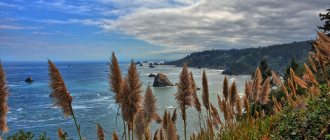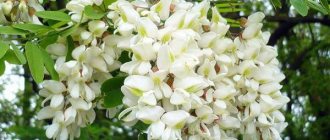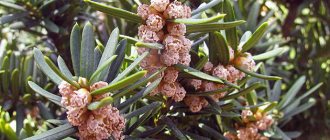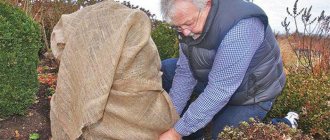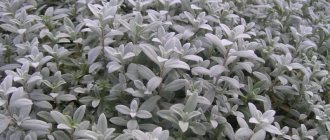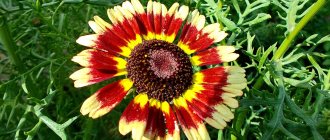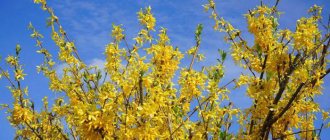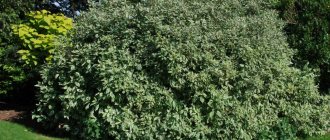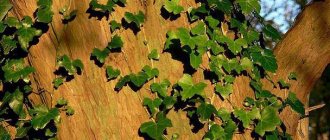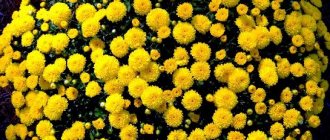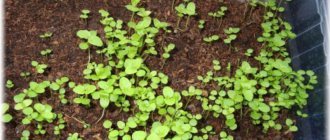Cortaderia silver and pink - planting, care, propagation
Ornamental grasses have recently gained great popularity.
They are universal in use, harmoniously combined with other plant species, regardless of the chosen style, and give the composition a unique texture, airiness, naturalness and grace. Cortaderia selloana is one of the most magnificent large, ornamental perennial grasses native to South America, including the Pampas region, which gives Cortaderia its second name, “pampas grass.”
In the right place for planting and good care, large varieties of cortaderia can reach 2.5-3 m in height.
Possible difficulties during cultivation
If pampas grass is not properly cared for, difficulties may arise when growing it. The main difficulties that gardeners face when planting and growing cortaderia include:
- The edges of the leaves are sharp and can easily hurt your fingers. Therefore, when digging or thinning a plant, you should use gloves;
- You should not grow cortaderia in places where children are constantly present, since the thorns on the edges of the leaves and the sharp edges of the leaf blades can hurt your hands;
- if you overdo it with drainage when planting a plant, the cortaderia will not receive enough nutrients from the soil. Due to the abundant rockiness, pampas grass grows sluggishly, the leaves sparingly cover the stem. After solving this problem, the grass quickly grows and fluffs up;
- severe frosts can damage the roots and kill pampas grass. In severe frost conditions, the perennial is grown as an annual. If you insulate the cortaderia well for the winter and avoid frost, it will delight you with its beauty for a long time.
- If pruned irregularly, pampas grass becomes overgrown and loses its beauty. Yellow dry leaves protrude unattractively against the background of young leaves and stems, which spoils the decorative appearance. To solve the problem, you should regularly trim dry foliage and inflorescences of pampas grass.
Cortaderia is a beautiful ornamental plant with great potential for ornamental use. Since the plant is rarely planted in gardens, its growth makes the garden surprising and unusual. The plant is unpretentious, but does not tolerate severe frosts. With proper care of pampas grass, it will please you with its appearance for many years.
Description and varieties
Pampas grass forms dense and lush turfs of tough, long and thin, curved leaves that form a green fountain shape. The edges of the leaf blade are covered with sharp teeth that can damage the skin or cause irritation.
Cortaderia is a beautiful late flowering plant whose decorative effect is fully revealed in the fall. In mid-summer, flower stalks begin to form from the center of the turf, similar to ears of corn in a shell.
At the end of growth, stunningly beautiful, long, fluffy, paniculate inflorescences, similar to feathers, are formed at the tops. Depending on the variety, they can be silver-white, cream or pink.
It is difficult not to pay attention to such beauty, especially since the majestic grass retains its decorative effect for a very long time and over time can grow into dense plantations.
Pampas grass is a dioecious plant that forms decorative panicles only on female plants. Male inflorescences are rather modest and small, so such specimens are not in wide demand.
In gardening, high varieties of silver cortaderia with huge inflorescences are popular: “Sunningdale Silver”, “Silver Comet”, “Silver Feather”. Of the pink cortaderia, the very spectacular variety “Rosea”.
Pink cortaderia "Rosea"
Low varietal forms are more hardy. These include the variety “Pumila”, 1.5 meters high with pink or silver-white inflorescences.
Reproduction by self-sowing
In warm regions with a favorable climate, pampas grass spreads incredibly quickly due to the independent dispersal of seeds. Seeds placed in favorable soil easily germinate and conquer vast territories, displacing other crops.
At the same time, the plant poses a danger to birds, which are injured by leaves with sharp edges. In addition, a large amount of grass that dries out over time often leads to fires. For these reasons, in some countries it is prohibited to cultivate cortaderia - it is mercilessly destroyed, like any other weed (cut down, flower stalks are cut, pesticides are used).
In temperate and northern latitudes, the plant is completely safe, as it does not spread by self-sowing. Under such conditions, it can grow only from the root or be specially bred in culture.
Related article:
Country garden: benefits and beauty without much hassle
Choosing a site for planting cortaderia
The best time to plant cortaderia is late spring, since the plant needs warm conditions to take root, adapt and grow, especially to prepare for the first frosty winter. The ideal growing location is sheltered from the wind, sunny or in diffuse shade.
Lowlands are not suitable for planting because the plant does not tolerate waterlogging. Cortaderia grows well in permeable and nutrient-rich soil, so before planting, mix the soil from the planting hole with compost or humus, and lay a drainage layer of expanded clay or broken brick at the bottom.
Silver and pink “Pumila”
After planting, the grass is well watered and the soil around is compacted. It is helpful to mulch the soil around the plant with compost or wood chips to maintain moisture and reduce weed growth.
Cortaderia in landscape design
Pampas grass looks original anywhere it grows - in a garden, in a park, on a flower bed or lawn. That is why it is often used as a decorative element in landscape design. Some designers use the cortaderia to create the original centerpiece of a fountain or waterfall.
Cortaderia looks good when planted in a park between benches, along the edges of fences or walls of houses. Bushes can be found near the gates of some buildings. In the garden, the perennial is the central decoration of the flower bed. When designing a garden, it is important to consider what flowers the perennial grows well with. Then you can plant grass in the background of low-growing plants.
Pampas grass gets along well near plants such as valerian, meadowsweet, delphinium, miscanthus, elecampane, dahlia, and aster. In the garden, grass can become an excellent hedge, because the height of the plant and its density perfectly protect from prying eyes.
Tips for caring for cortaderia
In general, care for cortaderia during the season is minimal. The plant tolerates drought well, but in the absence of rain for a long time during the rooting of young turf, regular watering is necessary. For an adult plant, seasonal rainfall is sufficient.
Variety "White-alba"
Under no circumstances should the soil be wet, since excess water leads to rotting of the roots and inevitable death of the plant. Increased soil moisture in frosts is especially dangerous, when the root system is most susceptible to the development of rot.
Cortaderia is not susceptible to diseases and pests. Its biggest enemy is moisture in the root zone. However, you can counteract this by choosing the right planting location and protecting your plants from moisture during the winter. Pests can be attacked by aphids, which provoke the development of sooty fungus.
Pampas grass - cortaderia: types, planting and care
Today we focus on pampas grass (Cortaderia). This is a herbaceous plant that can be an excellent decoration for a flower bed. It is also great for decorating paths or borders. Pampas grass can serve as a hedge or fence. Gardeners love the plant's graceful, fluffy feathers, which appear in midsummer and remain highly decorative even in winter.
In nature, pampas grass grows in Brazil, Argentina and Chile. Its name refers us to the Argentine steppes (pampas), which are its homeland. Cortaderia spread throughout the world in Victorian times, but is still one of the most popular ornamental grasses today.
Cortaderia leaf blades are very sharp (you can even cut yourself). This is why it is NOT RECOMMENDED to plant the plant if you have small children. In this case, pay attention to another ornamental grass - Muhlenbergia hairy.
The colored feathers of Cortaderia are more showy on female than on male plants. If the plant is not pruned, it can grow up to 3 meters in height. It should be remembered that the plant is highly flammable, so it is not recommended in areas where forest fires are common.
Diseases and pests
Ornamental grass has strong immunity and endurance. The ornamental plant does not have problems with garden pests due to its hard leaves, so preventive treatments are not required.
Ornamental grass has strong immunity and endurance.
In rare cases, the plant may be affected by anthracnose or powdery mildew. Then the affected parts are removed and sprayed with a fungicide. In dry and hot summers, pampas grass can be attacked by aphids or spider mites. Sick individuals are treated with insecticides.
Selecting a site for pampas grass.
Cortaderia does best in dry to moderately moist areas, in well-drained soils in full sun. The soil type can be any. Tolerates light shading well. It will not grow in full shade. It tolerates drought well, as it has a well-developed root system. It tolerates wind and salt, so it is also popular in coastal regions.
Female cortaderia plants produce enormous quantities of seeds. The plant is very invasive. If the conditions on the site are favorable, it can grow like a weed. For the middle zone, this is not so scary, since most wild plants will die in winter, but for the southern regions this can become a problem.
Pampas grass (without pruning) in landscape design
Requires a lot of space for normal growth. This is a large plant, so it is better to provide it with space. Plant bushes no closer than a meter from each other.
Use of the plant
Cortaderia looks great on the site in group plantings. It can be placed on bare ground or in the middle of the lawn. Green cascades are used to decorate ponds, but they should not be planted at the very edge of the water. There is also no need to plant cortaderia near paths; its prickly, tough foliage can injure you.
Dense thickets will serve as an excellent backdrop for a flower garden. Roses, peonies, verbenas, felt yarrow, spurge, echinacea and rudbeckia look good next to them. Lush multi-colored panicles can be used to make dry winter bouquets.
Pampas grass and our winters.
In the southern part of the country, pampas grass can be grown without any special care during the winter. In the middle zone it is necessary to cover the plant for the winter. Without additional measures, it can withstand temperatures down to -12 C. If you are afraid whether it is possible to grow cortaderia in our conditions, do not worry, it is possible, tested from your own experience.
Pampas grass is decorative even in winter
Types of pampas grass [photo + description]
Pink pampas grass (Cortaderia rosea) is known for its stunning pink tufts of large, silky flower heads. These inflorescences are often used in dried flower arrangements as well as fresh bouquets. Looks absolutely great! Grows quickly in an open sunny area.
White pampas grass (Cortaderia selloana ) is a large perennial grass. Feathers emerge from the tops of the stems. Most often they are white, silver or cream, but there are also purple ones.
Cortaderia jubata is larger than the previous two species. Can reach 7 meters in height. Less decorative, more invasive, and therefore practically not used for decorative purposes. Although some artificially bred varieties can still be considered as an option.
Propagation of pampas grass by seeds.
It should be noted that pampas grass seeds have excellent germination, so they can be planted in open ground in mid-spring, as soon as the soil warms up, however, to ensure 100 percent results, it is better to play it safe and germinate the seeds in containers at home.
- Prepare the container. The soil should be loose and slightly moist.
- There is no need to bury the seeds, just press them lightly into the ground. Seeds need light to germinate.
- Cover the container with a transparent bag. Leave a small hole for ventilation.
- Place the container in a sunny window; pampas grass needs six to eight hours of direct sunlight daily to germinate. T
- The room temperature should be between 18 and 23 degrees for best results.
- Keep the soil moist but not wet.
- The plant will begin to germinate in the second week.
- You can transplant it into open ground when the plant reaches 10–15 centimeters.
- When replanting, add a little bark to the soil for better drainage.
- At first, water the plant regularly; as soon as the plant gets stronger, it will no longer need additional watering.
Planting by seeds
Preparations for planting pampas grass with seeds begin in late winter - early spring. The seed material is stratified: placed in the refrigerator to break the seed shell. In April-May, the harvest is sown in boxes filled with humus. Since the seeds are very small, they are first mixed with sand and scattered over the surface of the soil. A 2-3 mm layer of soil is placed on top and sprayed with a spray bottle.
Within 2-3 weeks, young pampas grass seedlings grow from the seeds, which are immediately planted, transplanted into pots with a diameter of 10 cm and kept indoors at room temperature. In summer, containers with shoots are placed outside. In the first year, grass cannot be planted in the ground. With the onset of cold weather, the cortaderia is transferred to an insulated room without heating. Planting in the ground is planned in the second year of the seedling’s life.
Related article:
Flowers that bloom in large bells
Pampas grass seeds should be purchased from a trusted store. If you collect them from your own plot, you need to be sure that male and female bushes grow nearby. Cortaderia is a dioecious plant. The quality of the seed directly depends on the location of bushes of both sexes in close proximity to each other.
When growing grass from seeds, some of the seedlings will be male. They have a less spectacular appearance and are almost never used in landscape design. It is difficult to immediately select cortaderia bearing the female principle, since flowering when planted in a generative way occurs in 3-4 years.
Description
Cortaderia Sello is a perennial plant native to South America and belongs to the grass family. It is worth noting that in its homeland the culture is not valued at all - it is considered to be a weed. Nevertheless, the plant looks quite impressive.
Let's look at its main features:
- maximum height – 3 meters;
- the length of the leaves is about two meters, the ends and edges are sharp;
- the color of the foliage varies depending on the variety - it can be green, light gray, blue;
- The inflorescences are paniculate, their size reaches 40 centimeters, mostly white, but sometimes other colors can be found, for example, pink.
Cortaderia blooms in August, and this process continues until the first frost. If you want to see lush, beautiful bushes on your site, choose young female specimens of the crop. They perfectly withstand bad weather and remain unchanged throughout the fall, while the male ones quickly droop and wither.
Important: pampas grass has sharp leaves that cause irritation on the skin and are also easy to cut on. Therefore, experts recommend working with cortaderia with gloves, and also purchasing it with caution for those who have children walking on their property.
